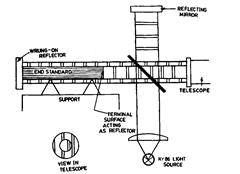3.6.
It is obvious from the method given above for comparing and verifying the sizes of gauges
that a considerable difficulty has to be faced in their use. This is because the working standard to
which one can refer is derived from a physical standard and in establishing the size of a working
standard by above process, successive comparisons must be made. This leads to errors of unaccep-
table order of magnitude. Using wavelength of monochromatic light which is natural and invariable
unit of length, the working standard is no more dependent upon the physical standard. Rather the
definition of a standard of length relative to the metre is expressed in terms of the wavelength of
the red radiation of cadmium. Thus for all practical purposes the use of phenomenon of the
interference of light waves to provide working standard may be accepted as ultimate.
For some time light wavelength standard had to be objected because of the impossibility of
producing pure monochromatic light as wavelength depends upon the amount of isotope impurity
in the elements. But now with the rapid development in atomic energy industry, pure isotopes of
natural elements have been produced. Cadmium 114, Krypton 86, and Mercury 198 are possible
sources of radiation of wavelengths suitable as natural standard of length.
Since wavelength standard is not a physical one, it need not be preserved. This is reproducible
standard of length, and the error of reproduction can be of the order of 1 part in 100 million.
Finally it was decided that Kr 86 is the most suitable element if used in a hot-cathode
discharge lamp maintained at 68 °K temperature. The orange radiation was selected for the
measurement. According to this standard, metre is defined as 1650763.73 x wavelength of the
radiation corresponding to the transition between the level: 2 pio — 5d5 of the Krypton 86 atom in
vacuum.

Fig. 3.9. No mechanical movement involved.
Some metrologists had predicted that the present length standard (krypton 86) will even-
tually be replaced by the laser (light amplification by stimulated emission of radiation). The great
advantage of the gas laser compared to other light sources is its coherency and strongly deflective
fringe pattern over long optical paths.
Today the gas laser is already established as a practical length-measuring tool in most of
the material bureaus. The measurement and calibration of gauges using wavelength standard have
been discussed in Chapter 6.
Wavelength Standard (Metrology)
Next post: End Standards (Metrology)
Previous post: Line Standard (Metrology)
